After some tough moments in April, Boca Juniors have performed when it matters most in May, winning the Copa de la Liga Profesional and finishing top of their Copa Libertadores group. Dropping points from winning positions in the league and 2-0 losses away at Deportivo Cali and Corinthians in the Copa Libertadores left work to be done. But Boca overcame the pressure, defeating Defensa y Justicia and Racing Club on penalties before beating Tigre in the Copa de la Liga Profesional final. Requiring a win in the last group stage game to progress into the knockout stages of the Copa Libertadores, Boca Juniors beat Deportivo Cali at La Bombonera in a tense affair.
In this tactical analysis in the form of a team scout report, we will discuss Sebastián Battaglia’s tactics that have guided Boca Juniors to domestic success and continental progression.
In possession
With goalkeeper Agustín Rossi ranking 29th out of all Liga Profesional goalkeepers for long passing accuracy, Boca Juniors prefer to play short in their build-up. Often playing to the centre backs, Boca sometimes have an asymmetric or rather narrow defensive line with wingers or central midfielders providing width near the halfway line. In this situation, the initially narrow full-backs are passing options that can access the wide areas. With central midfielders occupying more advanced spaces and Alan Varela consistently occupying the pivot space, the central midfielders are able to drop away from their markers to receive off the centre backs on either side of Varela to provide a route of progression.
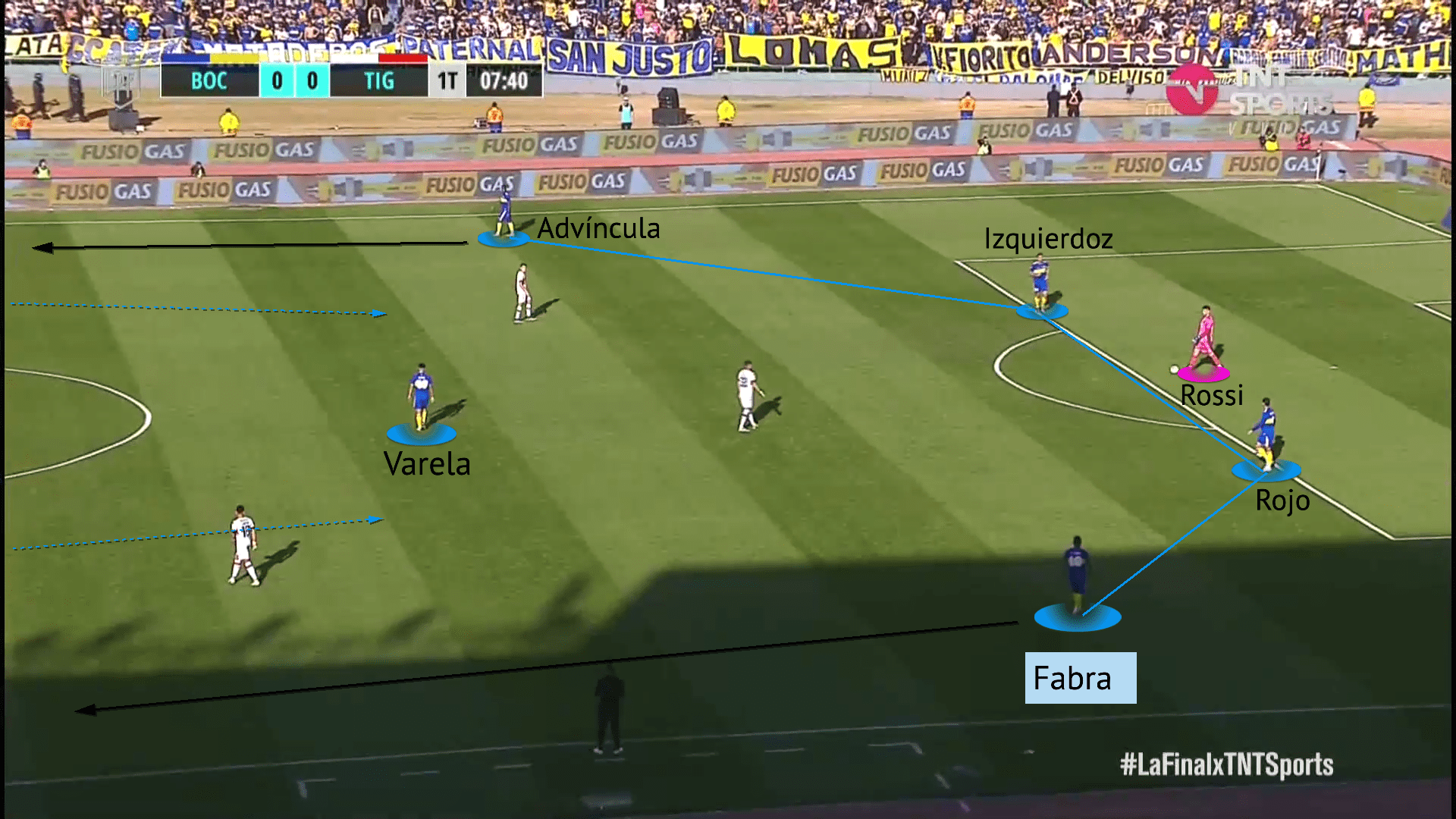
Central midfielders dropping to receive is also a common strategy from Boca Juniors in consolidated possession to enter the penetration phase of possession. This strategy is best executed with Óscar Romero dropping into the left half-space and playing a ball in behind for winger Sebastián Villa to utilise his dynamic superiority. Left-back Frank Fabra is very positive and forward-thinking in possession but only occasionally receives these passes from Romero, instead choosing his moments to advance into the final third and offer overlapping runs. On the other hand, right back Luis Advíncula regularly surges into the forward line as the right-sided width holder, allowing winger Eduardo Salvio to invert.
Against Corinthians’ high-line in the Copa Libertadores, Boca Juniors attempted these direct passes into the final third significantly more frequently. Averaging 53.21 passes into the final third this season, Boca Juniors attempted 83 in their dominant performance against Corinthians. This was aided by Battaglia’s tactical switch of dropping Guillermo Fernández to receive in the pivot space and shifting Varela to a right central midfielder.
Fernández is in the top 35% for passes into the final third per 90 of players who have played at least 600 minutes in the Liga Profesional, but what is most impressive is his 81% accuracy, ranking him 9th out of 316 players. Óscar Romero ranks 3rd for passes into the final third p90 from 175 midfielders and attackers to have played at least 600 minutes in the Liga Profesional, showing that both players have the abilities to penetrate. With Romero and Fernández capable of performing riskier passes, pivot player and fan favourite Alan Varela provides safer pass selections to balance the midfield. One of the division’s highest volume passers, Varela completes 95% of his attempted backwards passes and lateral passes to help Boca retain possession with his first-time passes.
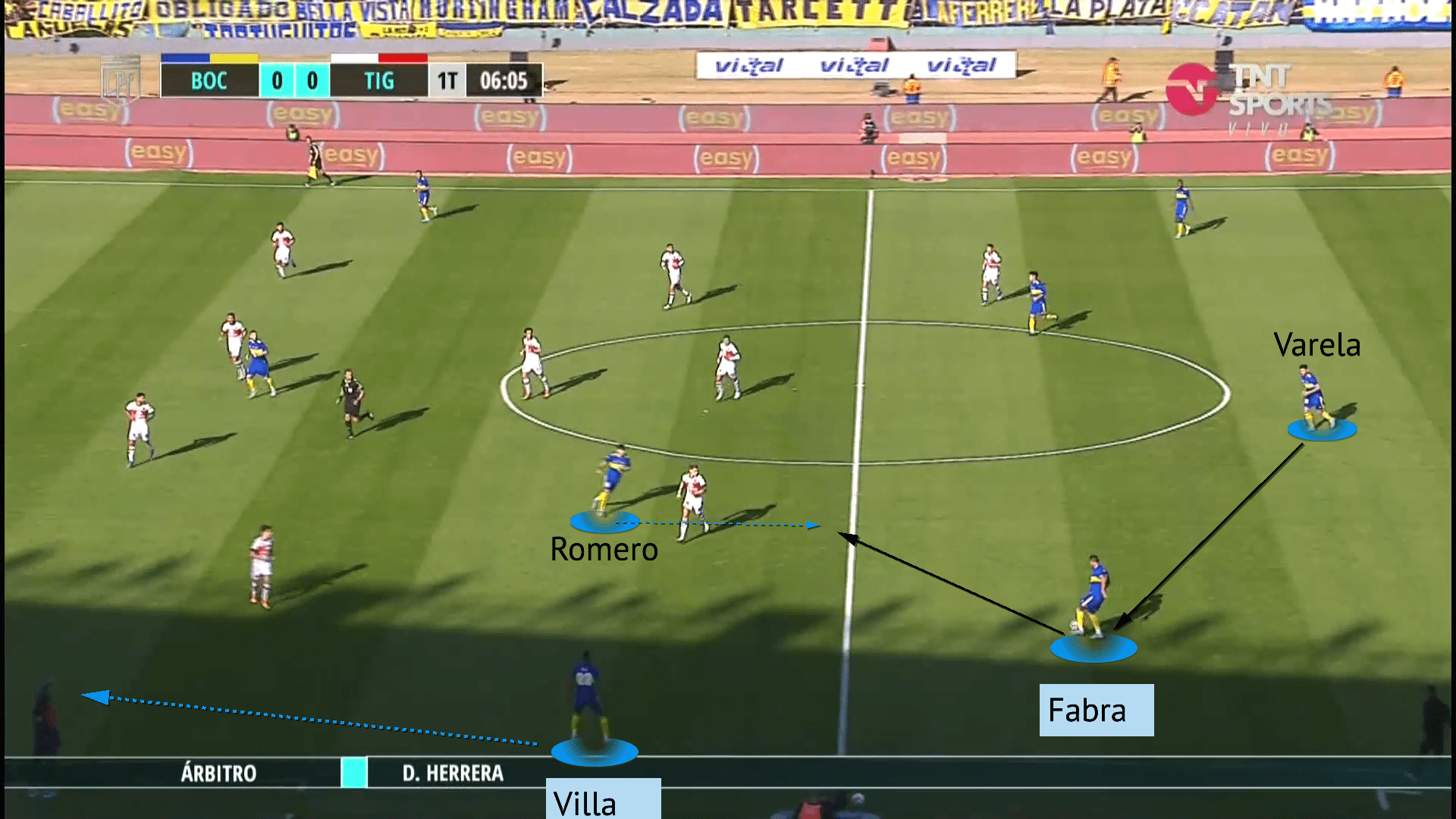
The two figures above and below show an example of Óscar Romero’s direct passing. Receiving a pass from Alan Varela, Fabra takes a touch and plays the ball into Romero’s feet as the Paraguayan midfielder drops to receive. Romero’s ball reception triggers Sebastián Villa’s sprint in behind, with striker Darío Benedetto’s movement also occupying Tigre’s ball-side centre back. Romero executes a penetrative pass with his second touch which allows Villa to get in behind and attempt a cross from the byline.
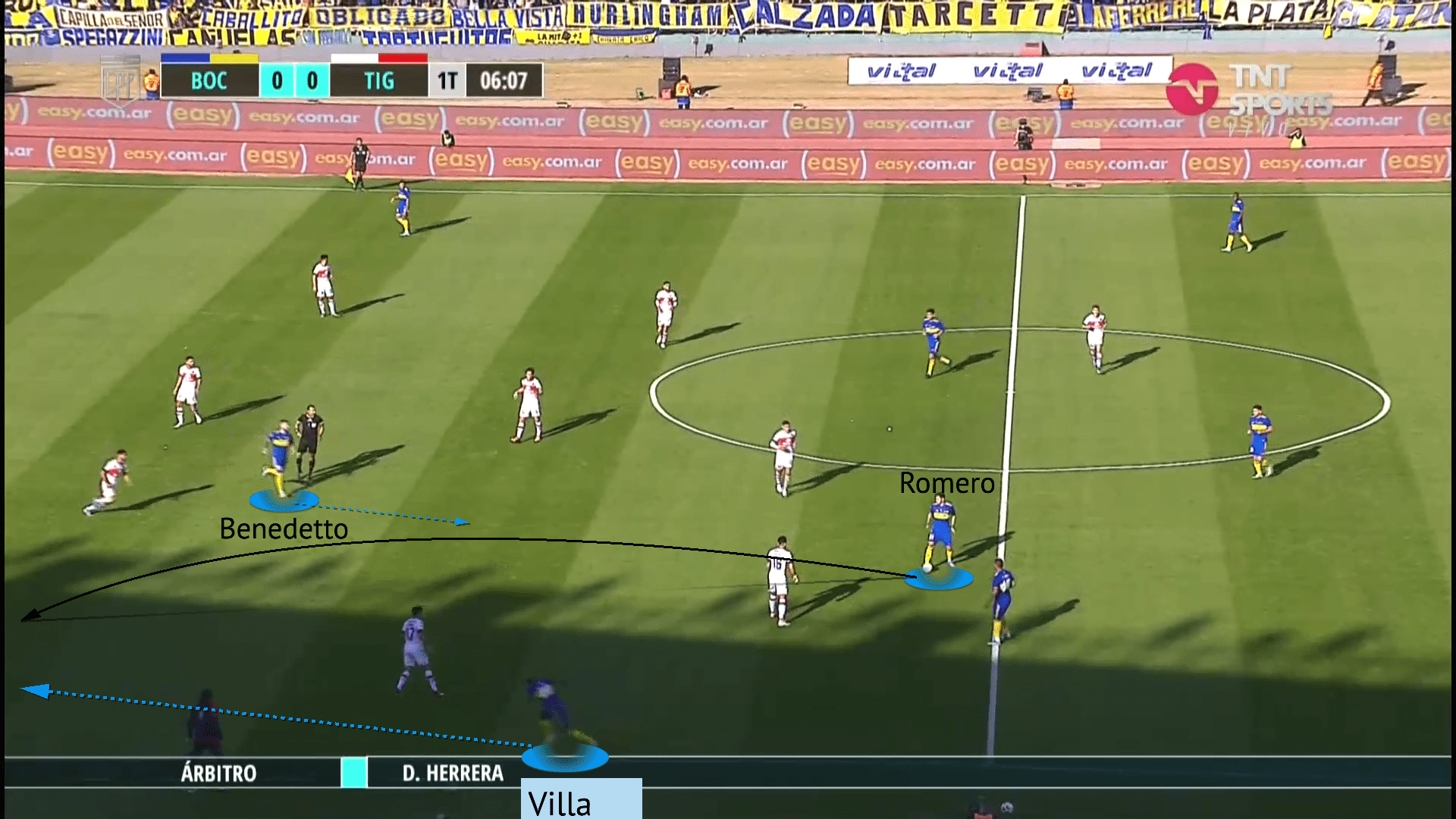
The figure below shows the rotation of holding midfielder Alan Varela and right central midfielder Guillermo Fernández. Fernández drops to receive and instantly changes possession from the build-up phase to the penetration phase, finding the in-behind run of former Atlético Madrid right-winger Eduardo Salvio. Whilst capable of executing these passes, Varela rarely attempts them and against Corinthians’ high line, these passes were effective from Fernández.
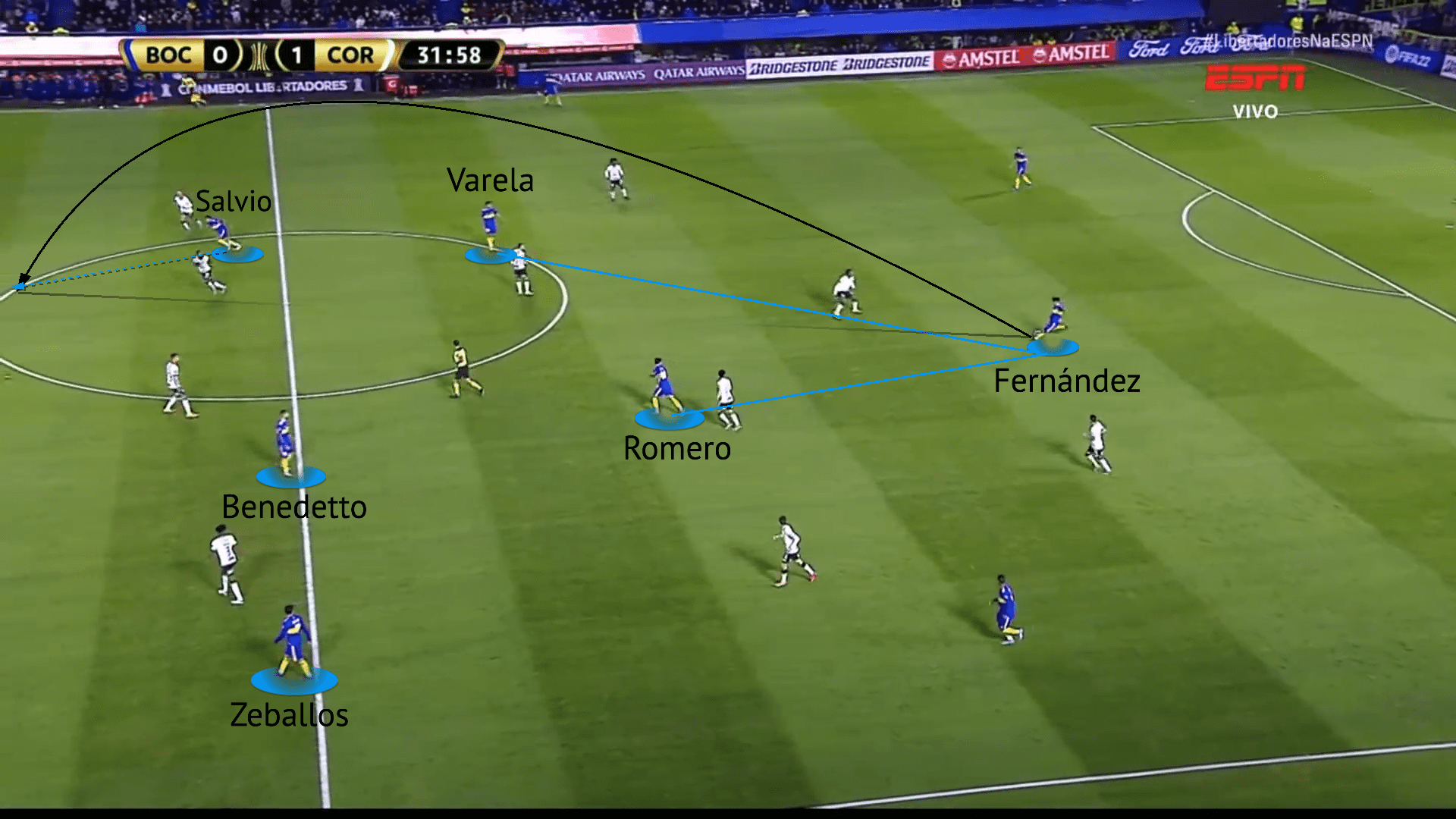
Not only are Boca’s wingers key for penetrating, but they are also crucial for attacking transitions and overall attacking play too. Their three-man winger selection of Sebastián Villa, Salvio, and Exequiel Zeballos are all gifted dribblers that can use their technique and pace in tight or open spaces. Offering the runs in behind for the more direct passes like above, the wingers still add great value when on the ball with Villa ranking 5th in the Liga Profesional for xG+xA with 7.33. In attacking transitions, Boca have a reliance on the wingers’ ball-carrying and ability to stretch opposing defences as outlets after regaining possession. Boca Juniors’ 32.83 dribbles and 1vs1’s per 90 is the highest in the Liga Profesional this season.
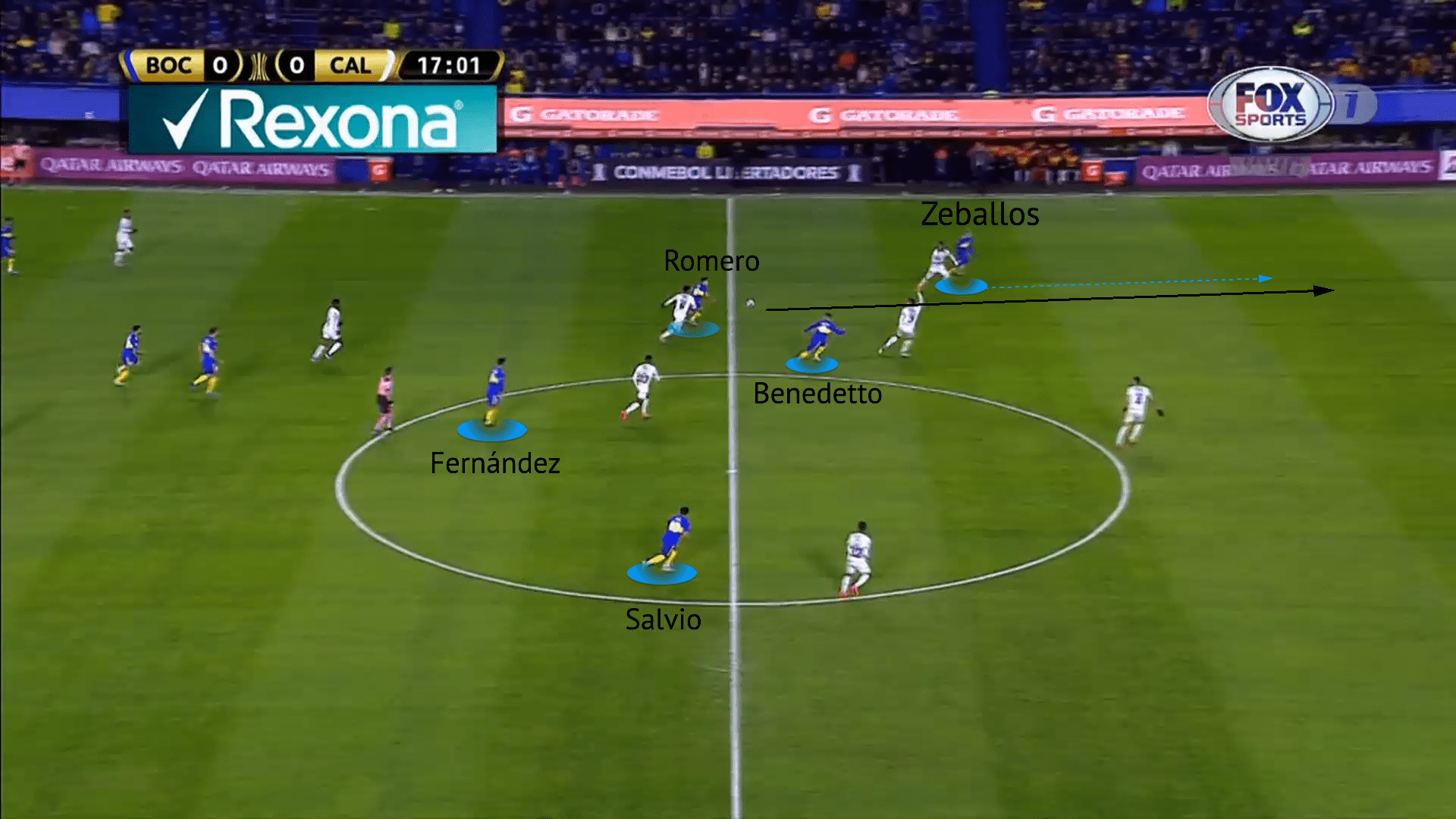
Attacking set-pieces
Boca Juniors set-pieces are shared between left-footed Óscar Romero and right-footed Villa, with right-footed youngster Exequiel Zeballos another option. Villa’s corners are mainly taken from the right, whereas Romero can provide inswinging deliveries from the right and outswinging from the left. Boca usually have five players in the box and two players on the edge. At least one player will make a run to the front zone for potential near-post flick-ons, especially from Romero’s deliveries, with another ghosting to the back-post. However, Sebastián Battaglia’s side tend to cross deeper near the six-yard box towards the back post.
The main targets from the corners are centre backs, with the deeper delivery giving them time to read the ball flight to attack the ball. Out of 256 Liga Profesional players to have played more than 700 minutes, Marcos Rojo ranks in the top 20% of successful aerial duels %, with 58.82%. Boca Juniors’ second-highest minute-taking centre back after Rojo is Carlos Zambrano, who has won 62.5% of his aerial duels in all competitions this season. Compared to Rojo, left-back Fabra is in the top 6% with 65.52% success, but Fabra stays back from corners due to his superior SAQ (Speed, Agility, and Quickness) against potential opposition counterattacks.
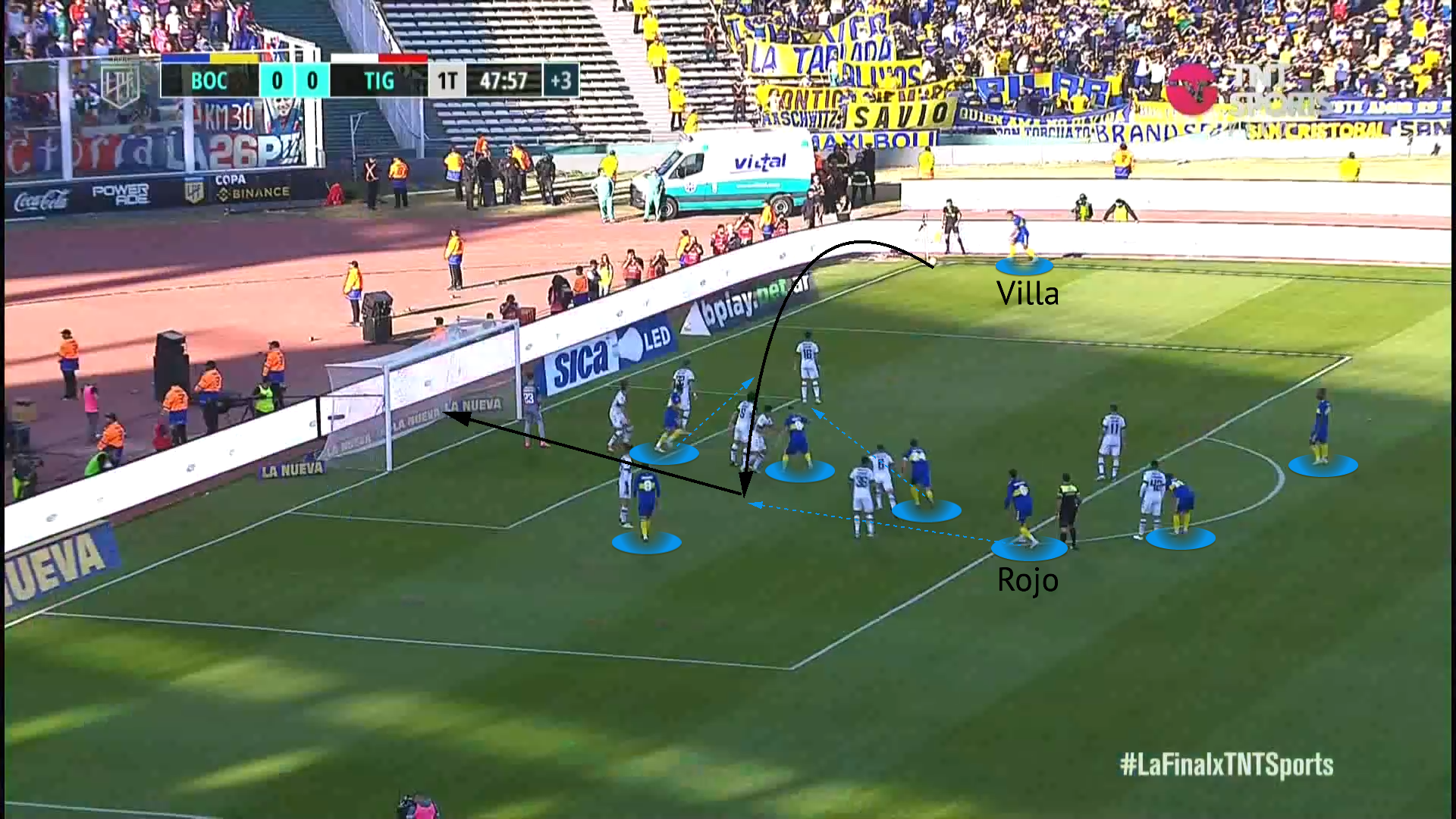
This figure shows Boca Juniors’ most common set-up recently with two players on the edge of the box. Rojo enters the box as the corner is taken, giving himself the space to run and attack the ball. This is an effective strategy from the former Manchester United defender, as he generates more power on his headers towards goal. From this set-piece, Guillermo Fernández is ready to ghost past his marker at the back post.
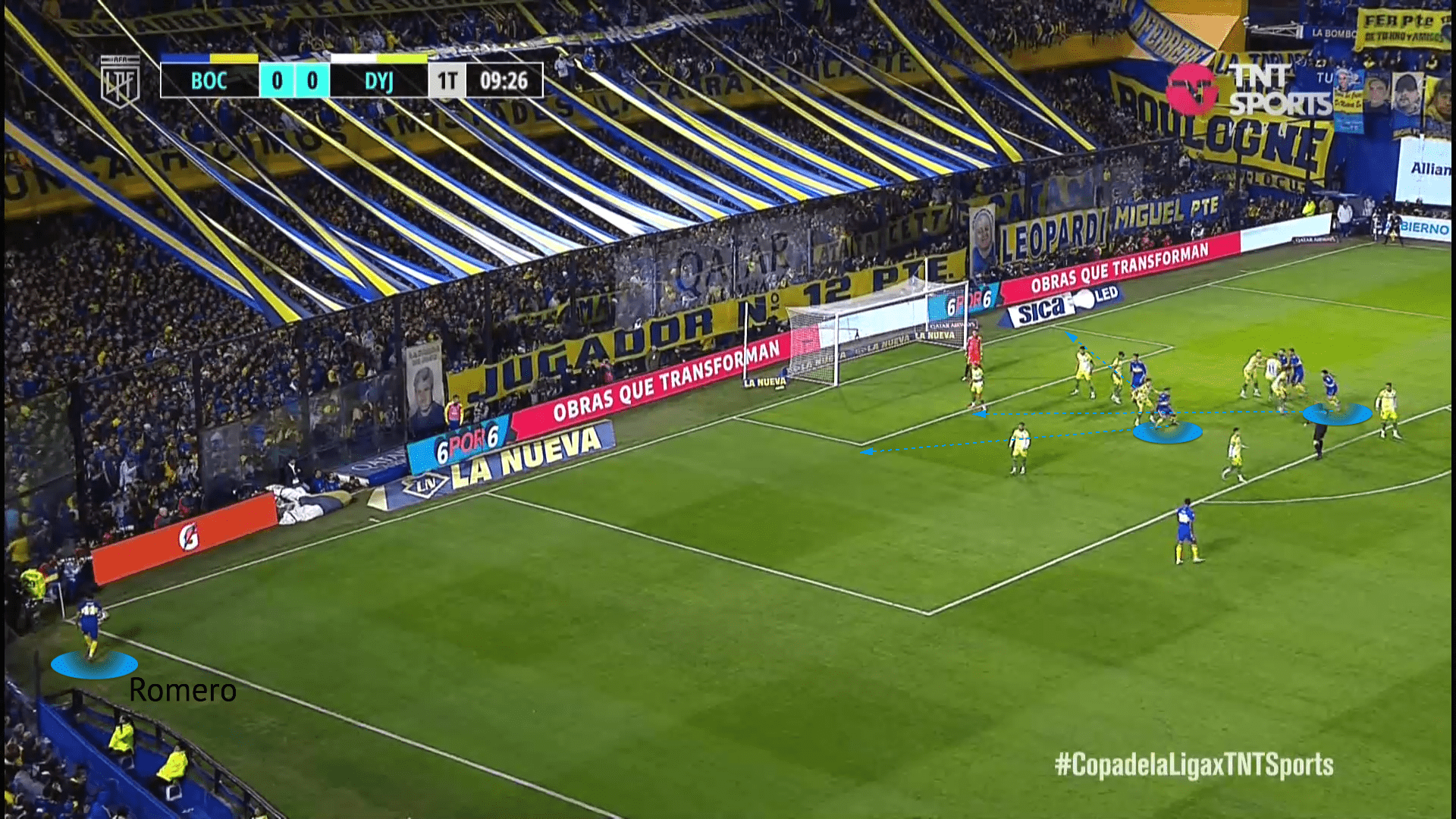
This figure shows one of Óscar Romero’s outswinging corner deliveries from the left. Two Boca Juniors’ players make runs into the front zone, with another peeling away from his marker towards the back post.
From Romero’s inswinging deliveries from the right, Sebastián Villa commonly provides a short corner option. This takes an opposition player out of the penalty box, but Boca Juniors also usually remove a player from the box to provide more defensive support. If the ball is played short, Villa will cross early, being direct rather than playing backwards to retain possession. This tendency of being direct continues in Boca Juniors attacking free-kicks, always delivering the ball into the box with Villa often the taker.
Out of possession
Boca Juniors have adapted their defensive shape against the opposition depending on formations and game state. Boca can transition their 4-3-3 shape to a 4-1-4-1 out of possession mid-to-low block when experiencing spells of pressure. In these situations, they tend to trust Battaglia’s set-up and their player quality to prevent opposition penetration and regain possession. Despite having an xGA of 19.52 and an xG per shot against of 0.11, ranking them 21st and 17th in the league for those metrics, Boca Juniors have conceded just 11 goals, with only Racing Club conceding less.
Against teams who have a player occupying the pivot space, Boca Juniors will line up in a 4-2-3-1, with Óscar Romero pushing up to attacking midfield. Boca usually don’t press the goalkeeper when they are in possession, instead, they look to cut off short passing options to force longer passes. They accomplish this with the wingers narrowing, ready to press centre backs from behind and intercept low passes to full-backs. However, this opens space for opposition full-backs/wing-backs to receive.
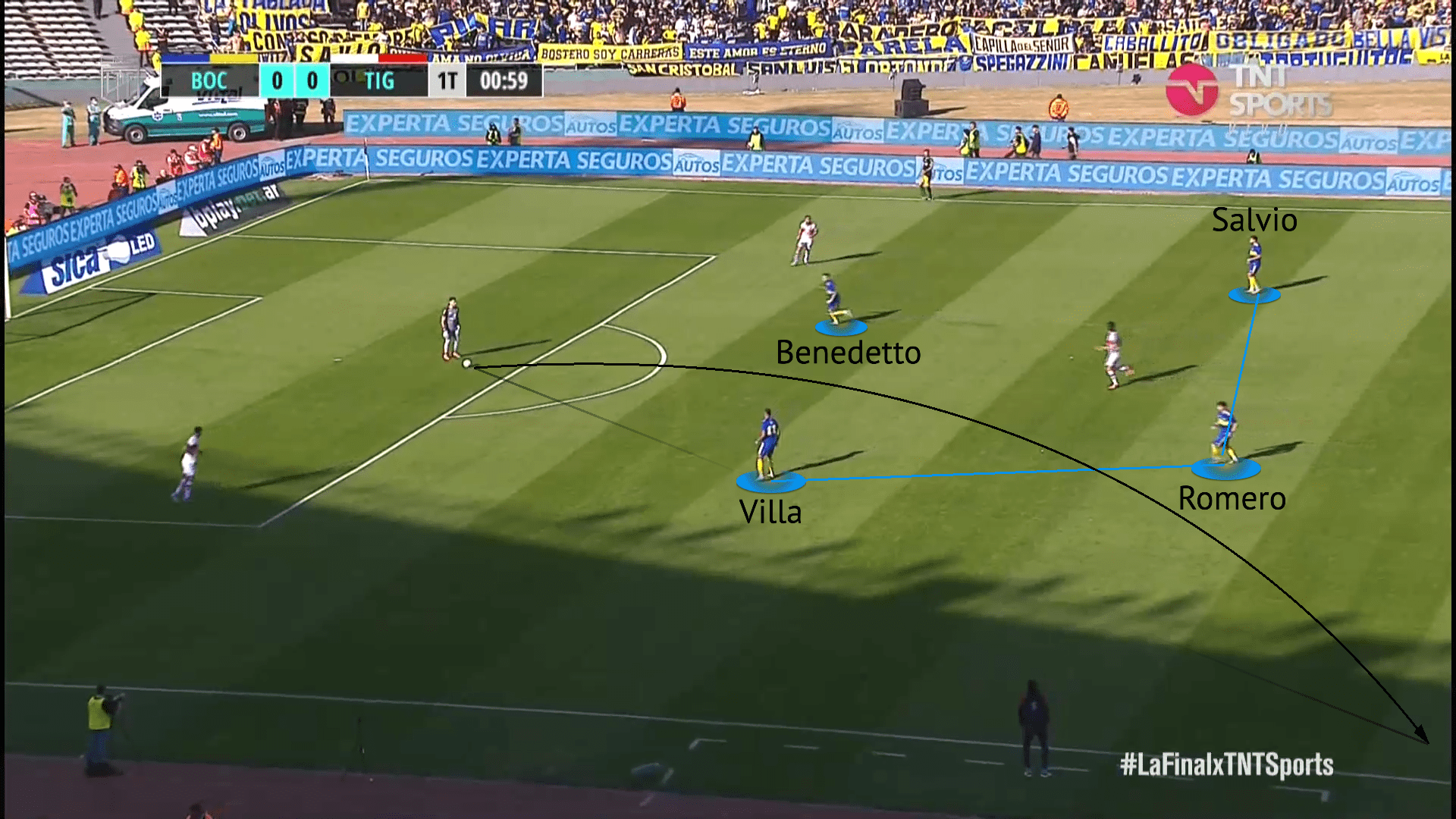
In this example, Tigre’s goalkeeper has time to play a pass up to the right back in the space behind left-winger Sebastián Villa. Romero has stepped up towards the Tigre player occupying the pivot space. With the Tigre right back free to receive, Boca’s left-back Frank Fabra begins to close him down, distorting the defensive line.
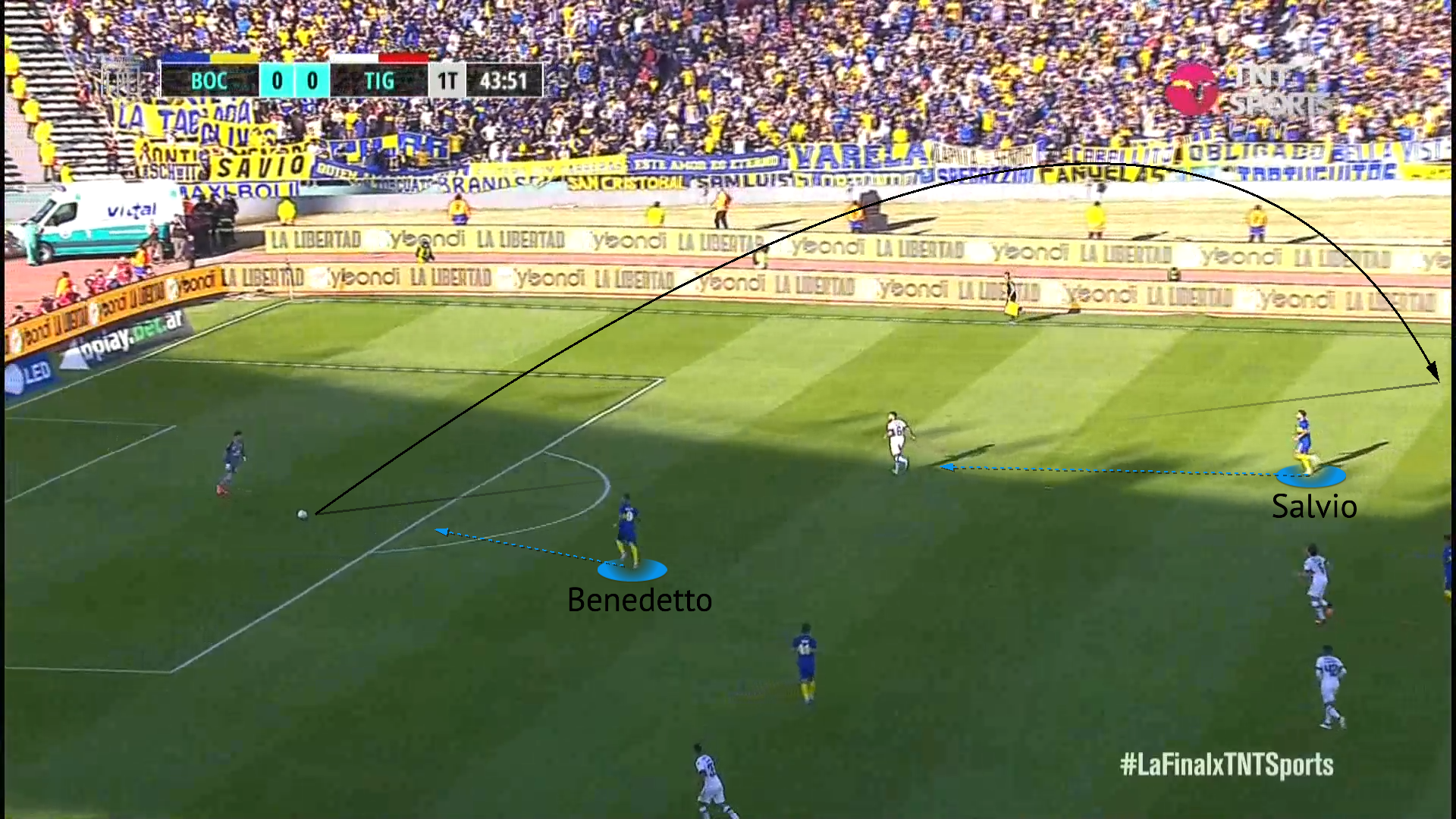
Here, Boca have forced Tigre’s possession back to the goalkeeper and have momentum. Benedetto is closing down the goalkeeper and right-winger Salvio is closing the short passing option. Salvio’s pressing creates greater space between him and right back Luis Advíncula in the right-wing dyad, enlarging the area the Tigre goalkeeper has and pass into to find the left-back. The figure below shows Salvio tracking back and Advíncula pressing out to the left-back. The left-back can play inside, springing Tigre into attacking the Boca Juniors defence 4vs3.
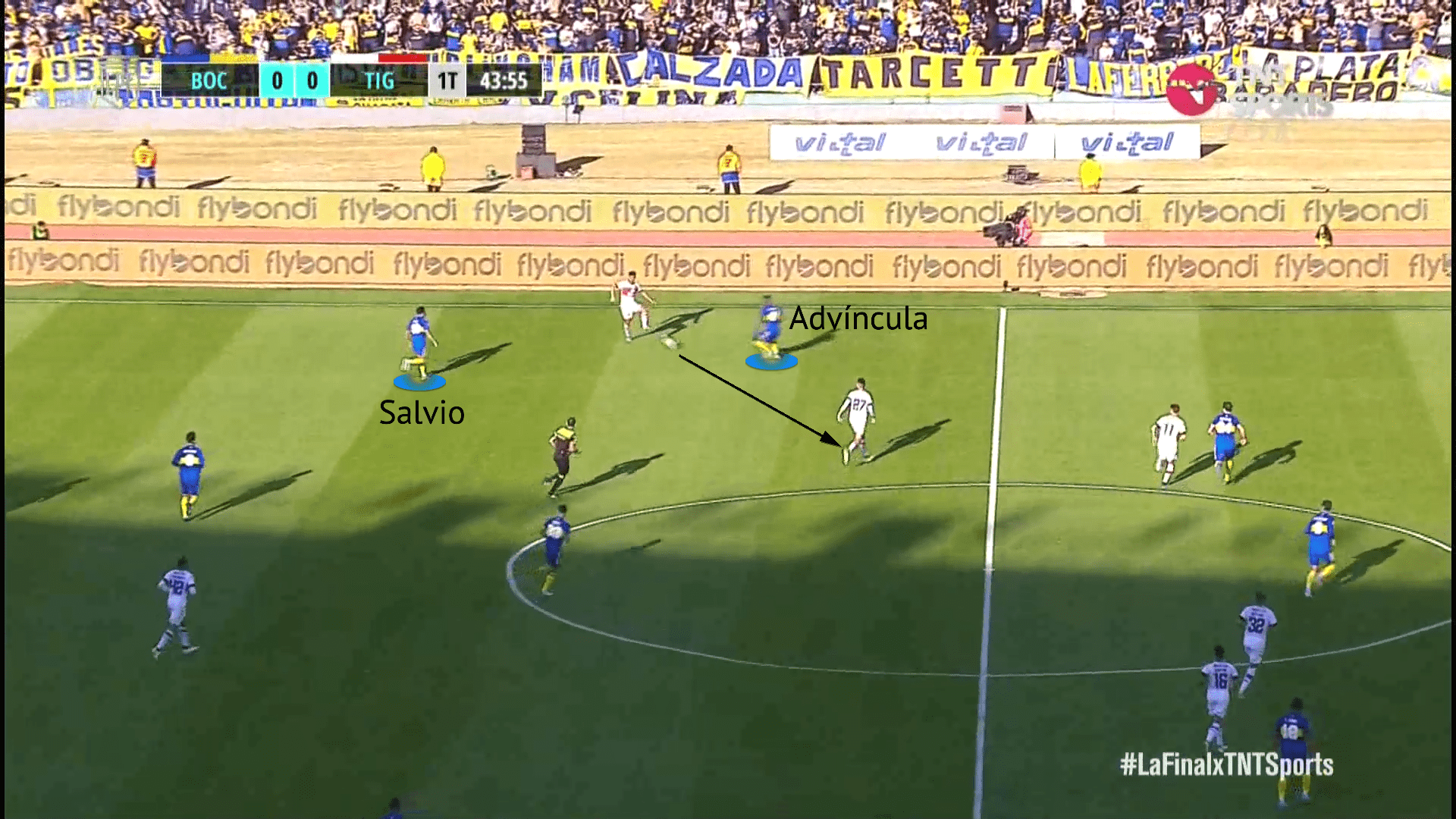
The figure below shows an example of Corinthians using their 5-2-3 formation. The combination of Corinthians’ three centre backs matches up with Boca’s three attackers and the Corinthians double-pivot dropping deep to bring out central midfielders Romero and Fernández, there are large spaces for Corinthians’ wing-backs to exploit. With Boca Juniors’ defence initially concerned by Corinthians’ front three, the right wing-back was able to receive before eventually being closed down by Fabra. But the right wing-back was still able to pass up the channel, threatening Boca in behind.
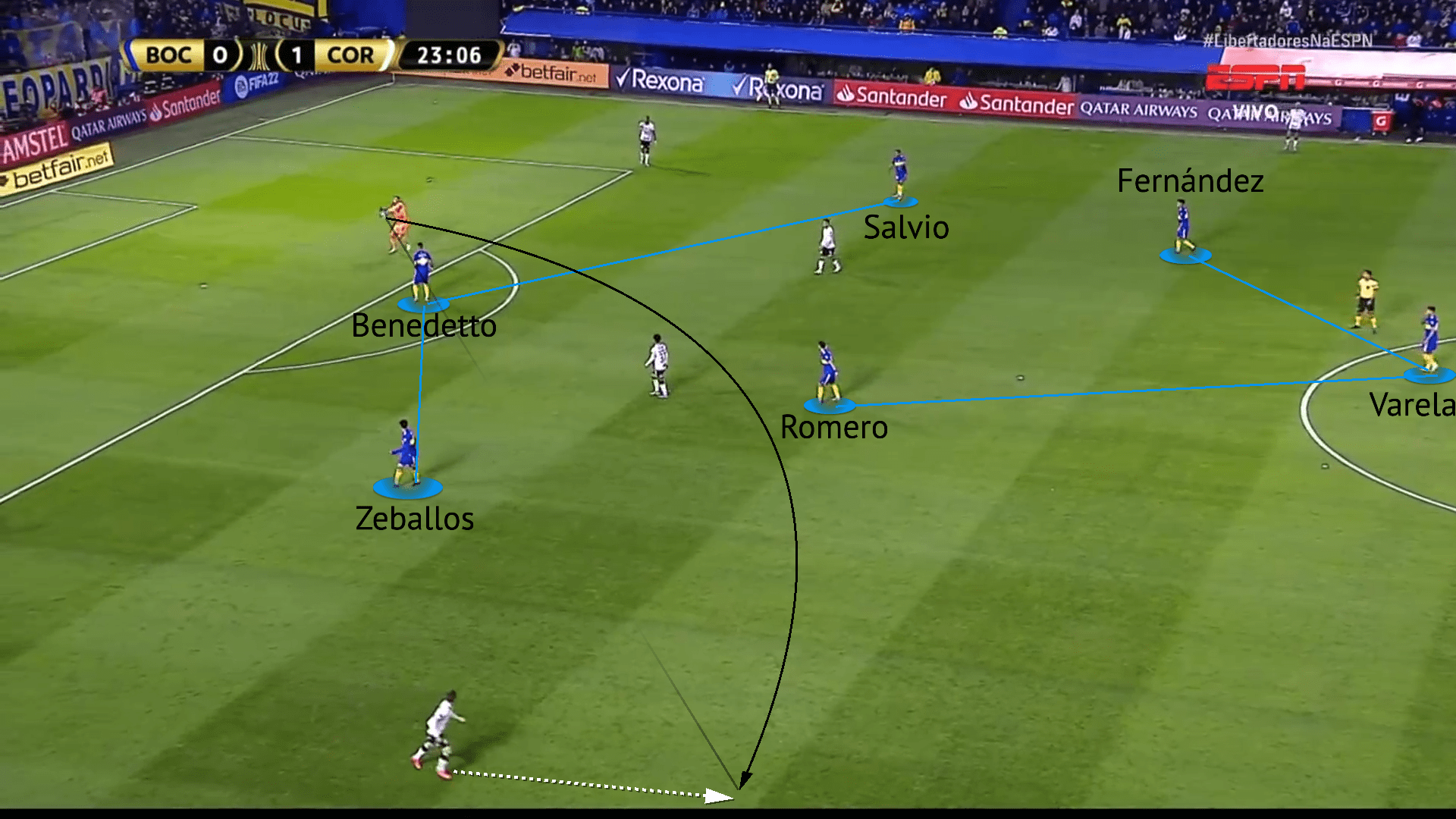
However, not only is the space for opposition full-backs increased by Boca’s winger movements but it is also increased by their narrow defensive line. In preparation for long passes towards the opposition striker, Boca narrow their defence to guard against opposition supporting runs and drop behind the engaging centre back to cover. This, in turn, creates more space for opposition full-backs to receive off the goalkeeper.
In the example below against Deportivo Cali, centre back Carlos Izquierdoz has engaged in the aerial duel with the remaining defence of Fabra, Rojo, and makeshift right-back Nicolás Figal narrowing and covering behind. Holding midfielder Alan Varela has also retreated behind Izquierdoz to fill the defensive line, something the intelligent midfielder regularly does in situations where Boca centre backs are drawn out of possession, especially into wide areas.
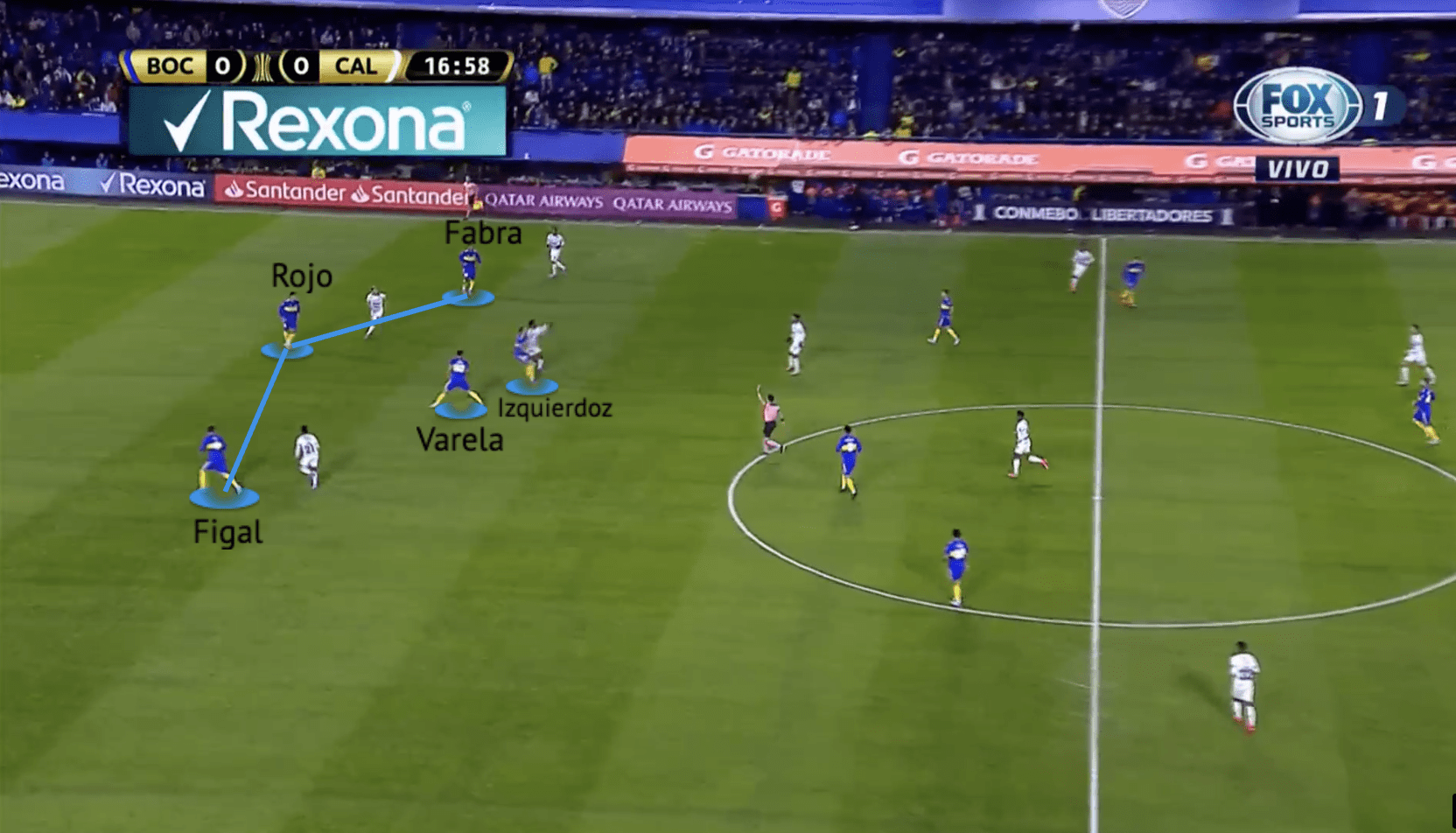
Defending set-pieces
Rather than having a consistent defensive set-up, Boca Juniors change their approach to defending corners based on their opposition. However, there are some constants, with Boca always having a player on each opponent inside the box and goalkeeper Agustín Rossi staying on his goal line, not coming to collect crosses. A frequent strategy from Sebastián Battaglia is to have a player positioned near the corner, to affect the taker. This is a guarantee when the opposition have a short corner option.
Inside the box, Boca Juniors tend to prioritise front zone cover. Against Corinthians in the Copa Libertadores, Boca had a player on the front post and another in the front zone. Against Racing Club and away against Tigre, they often had players deployed in the front zone and the middle zone. However, even when Boca Juniors don’t have a player in the front zone, a middle zone player will move towards the front zone upon corner delivery. This occurred regularly versus Defensa y Justicia and the Liga Profesional playoffs final against Tigre.
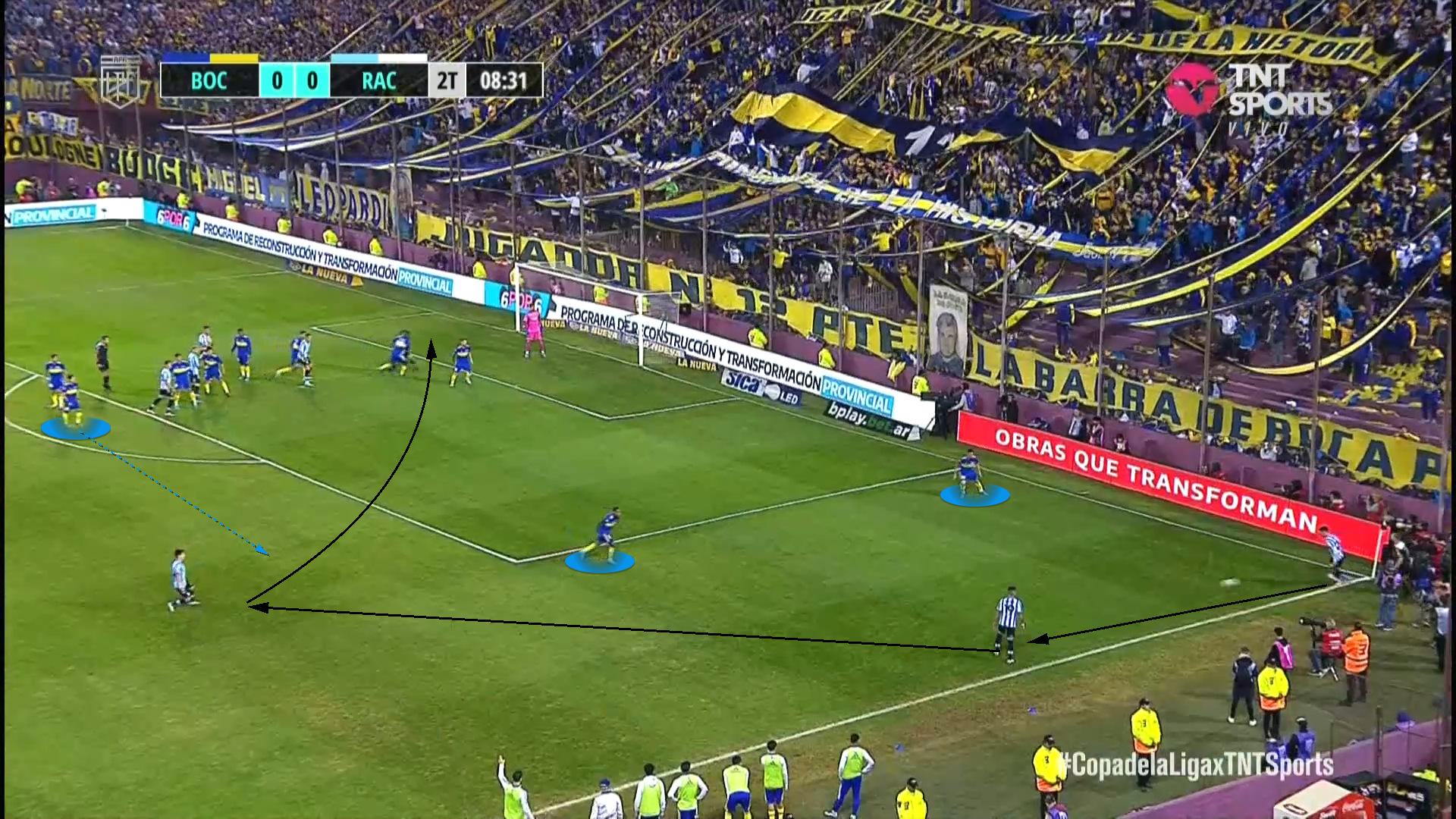
This figure shows Boca Juniors man-marking Racing Club players inside the box 6vs6, with a spare player in the middle zone. Racing Club play the corner short, triggering the two Boca players to close down the receiver. Racing Club manage to work the ball back to their free-man on the edge, who crosses into the box. One of Boca’s players on the edge of the box makes a run across in an attempt to block the cross.
From opposition free-kicks, Boca Juniors have all players back to defend. Usually, they have a two-man wall with a player covering a wide option. The remaining players are in the defensive line, or supporting to overload, as shown in the example below against Tigre. Goalkeeper Rossi leaves his line more from free-kicks but chooses to deflect and punch the ball away instead of catching it.
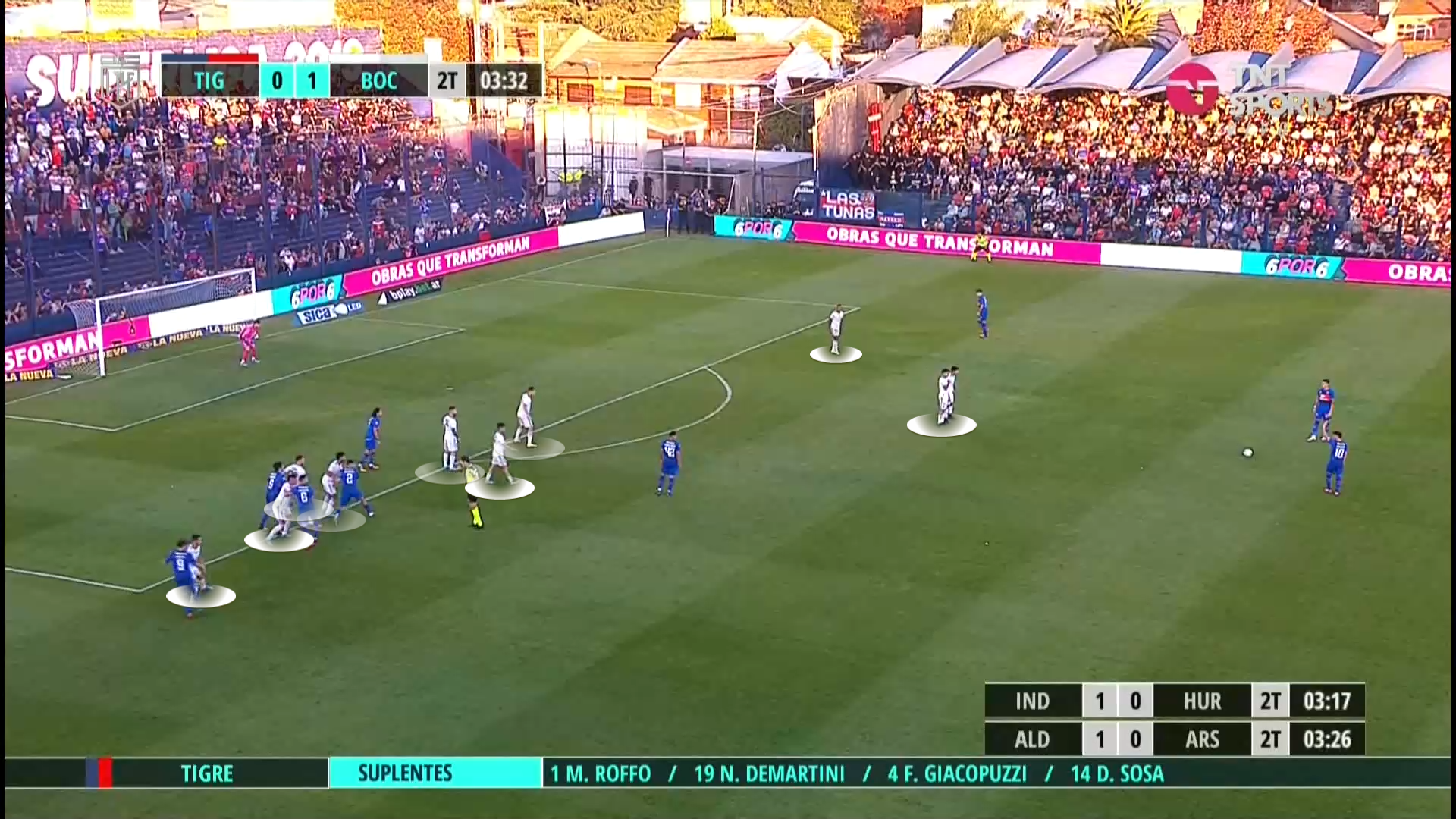
Conclusion
Winning six of their seven games in May, Boca Juniors have transformed their first half of 2022 from good to excellent. This team analysis and scout report has discussed Sebastián Battaglia’s tactics that helped Boca win the Copa de la Liga Profesional and finish top of their Copa Libertadores group, ahead of Corinthians, Deportivo Cali, and Always Ready. But Boca have even larger aims for 2022, with June welcoming the beginning of the Primera División and the Copa Libertadores knockout stages. Sebastián Battaglia’s side also faces tough group stage opponents Corinthians again.
Nevertheless, it is exciting times at Boca Juniors, as they look to reclaim the Primera División title from cross-town Superclásico rivals River Plate. With their transfer activity in the last two windows and their most common starting XI recently having an average age of 29.3 years, Boca’s intention leans towards a ‘win now’ approach. Sometimes, this approach can bring short-term success but hinder long-term development. However, Battaglia is proactively guiding the next batch of starters at Boca Juniors. Holding midfielder Alan Varela (aged 20) has been essential to Boca lately, with central midfielder Cristian Medina (19), winger Exequiel Zeballos (20), and striker Luis Vázquez (21) providing influential roles with Boca’s congested fixture schedule. With academy left-back Valentín Barco (17), linked with Manchester City, having world-class potential and central midfielder Ezequiel Fernández (19), impressing on loan at Tigre, the future is also bright for Argentinian giants Boca Juniors.

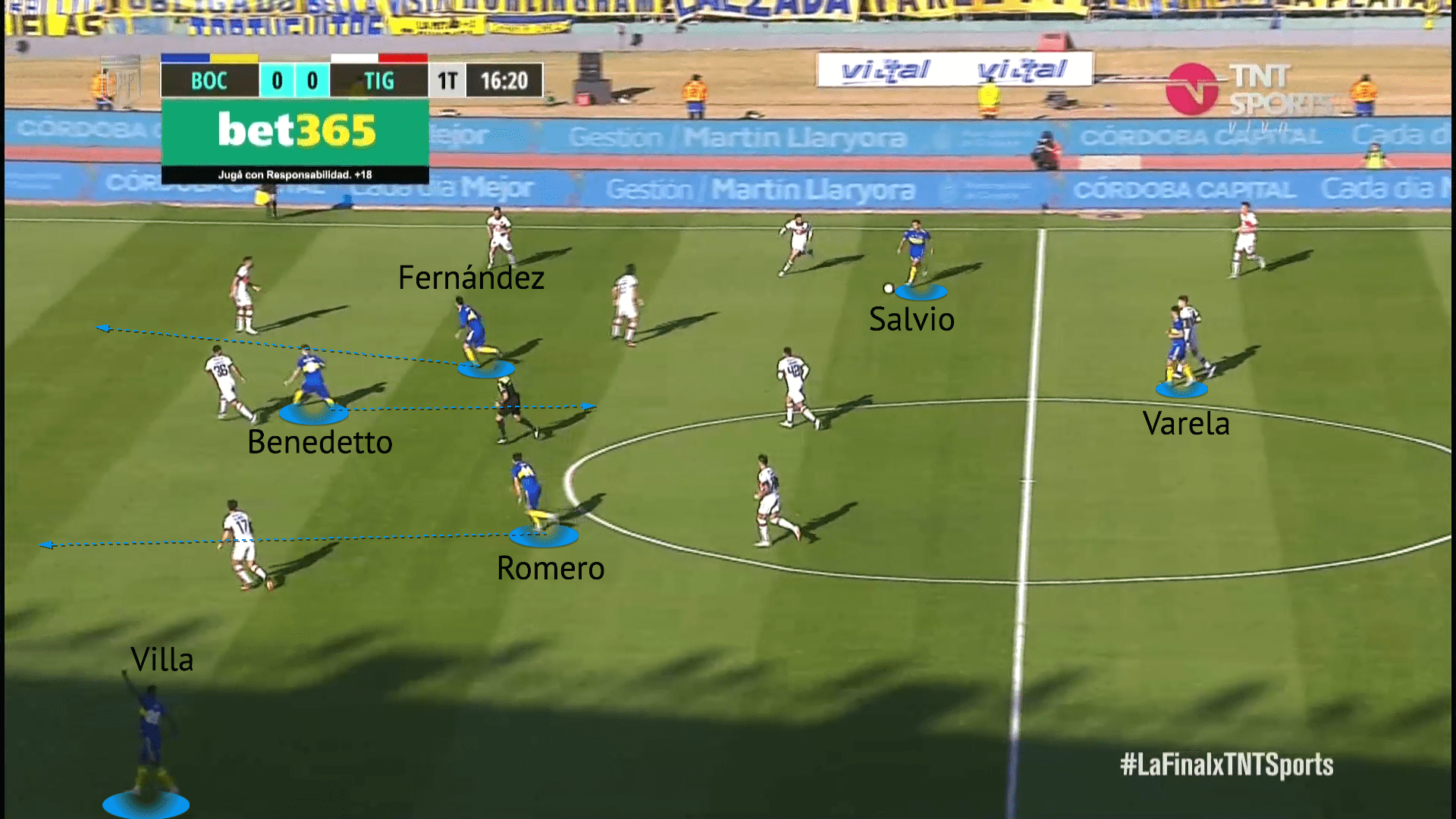




Comments